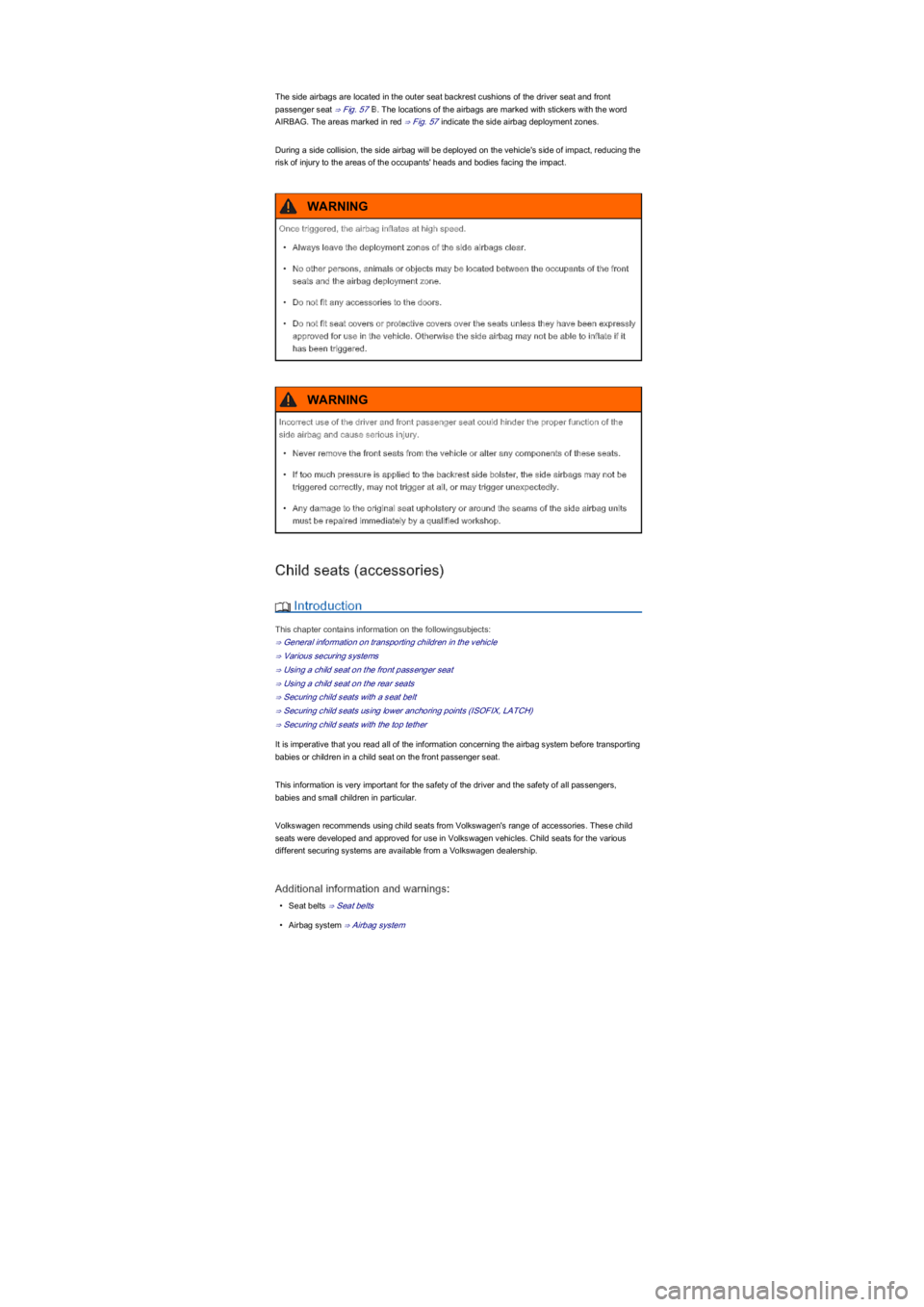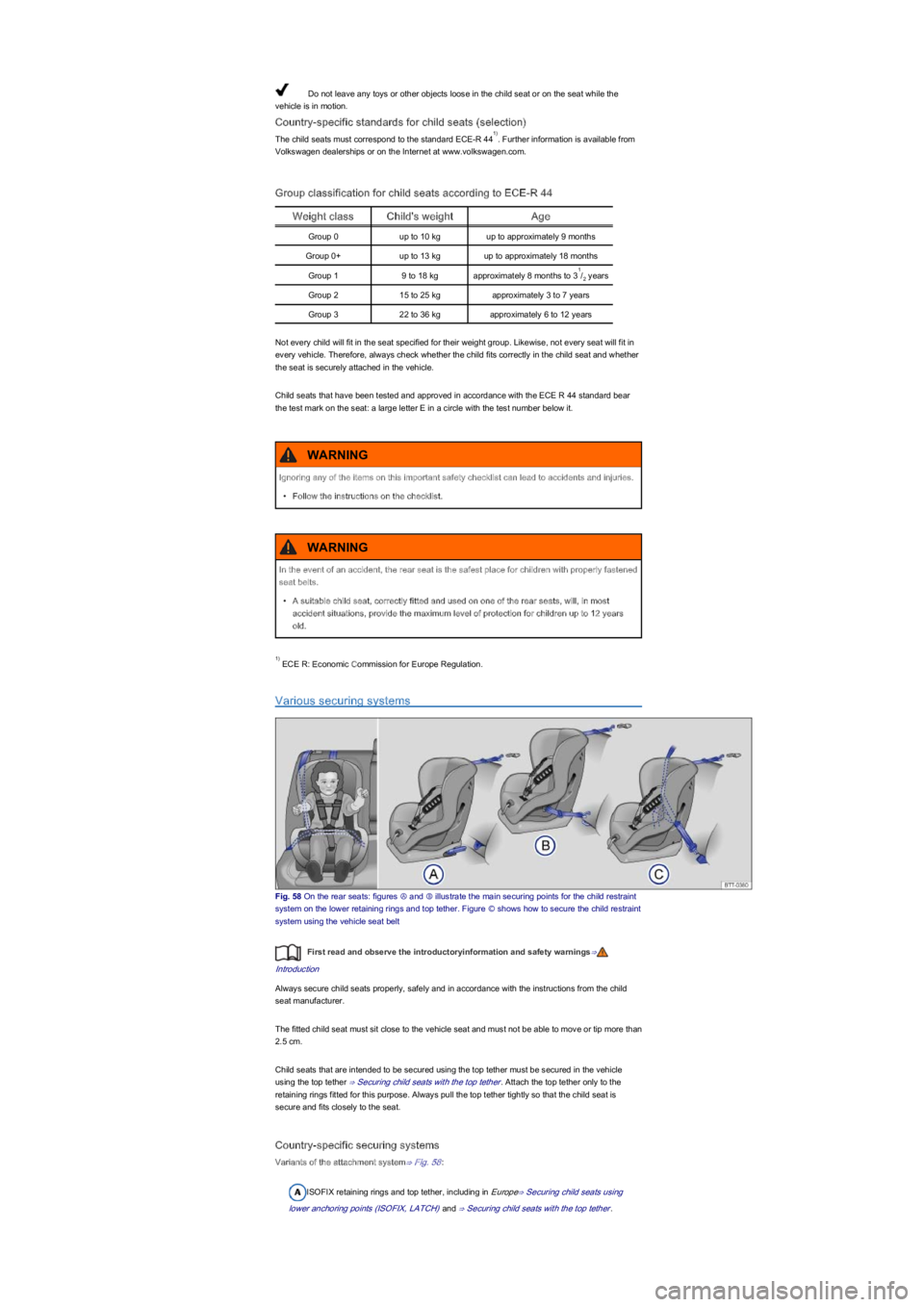Page 53 of 211

The side airbags are located in the outer seat backrest cushions of the driver seat and front
passenger seat ⇒ Fig. 57B. The locations of the airbags are marked with stickers with the word
AIRBAG. The areas marked in red ⇒ Fig. 57 indicate the side airbag deployment zones.
During a side collision, the side airbag will be deployed on the vehicle's side of impact, reducing the
risk of injury to the areas of the occupants' heads and bodies facing the impact.
Child seats (accessoriesyf
Introduction
This chapter contains information on the followingsubjects:
⇒ General information on transporting children in the vehicle
⇒ Various securing systems
⇒ Using a child seat on the front passenger seat
⇒ Using a child seat on the rear seats
⇒ Securing child seats with a seat belt
⇒ Securing child seats using lower anchoring points (ISOFIX, LATCHyf
⇒ Securing child seats with the top tether
It is imperative that you read all of the information concerning the airbag system before transporting
babies or children in a child seat on the front passenger seat.
This information is very important for the safety of the driver and the safety of all passengers,
babies and small children in particular.
Volkswagen recommends using child seats from Volkswagen's range of accessories. These child
seats were developed and approved for use in Volkswagen vehicles. Child seats for the various
different securing systems are available from a Volkswagen dealership.
Additional information and warnings:
\f
Page 55 of 211

Do not leave any toys or other objects loose in the child seat or on the seat while the
vehicle is in motion.
Country-specific standards for child seats (selectionyf
The child seats must correspond to the standard ECE-R 44. Further information is available from
Volkswagen dealerships or on the Internet at www.volkswagen.com.
Group classification for child seats according to ECE-R 44
Weight classChild's weightAge
Group 0up to 10 kgup to approximately 9 months
Group 0+up to 13 kgup to approximately 18 months
Group 19 to 18 kgapproximately 8 months to 3/ years
Group 215 to 25 kgapproximately 3 to 7 years
Group 322 to 36 kgapproximately 6 to 12 years
Not every child will fit in the seat specified for their weight group. Likewise, not every seat will fit in
every vehicle. Therefore, always check whether the child fits correctly in the child seat and whether
the seat is securely attached in the vehicle.
Child seats that have been tested and approved in accordance with the ECE R 44 standard bear
the test mark on the seat: a large letter E in a circle with the test number below it.
ECE R: Economic Commission for Europe Regulation.
Various securing systems
Fig. 58 On the rear seats: figures Ⓐ and Ⓑ illustrate the main securing points for the child restraint
system on the lower retaining rings and top tether. Figure Ⓒ shows how to secure the child restraint
system using the vehicle seat belt
First read and observe the introductoryinformation and safety warnings⇒
Introduction
Always secure child seats properly, safely and in accordance with the instructions from the child
seat manufacturer.
The fitted child seat must sit close to the vehicle seat and must not be able to move or tip more than
2.5 cm.
Child seats that are intended to be secured using the top tether must be secured in the vehicle
using the top tether ⇒ Securing child seats with the top tether. Attach the top tether only to the
retaining rings fitted for this purpose. Always pull the top tether tightly so that the child seat is
secure and fits closely to the seat.
Country-specific securing systems
Variants of the attachment system⇒ Fig. 58:
ISOFIX retaining rings and top tether, including in Europe⇒ Securing child seats using
lower anchoring points (ISOFIX, LATCHyf and ⇒ Securing child seats with the top tether.
1yf
1
2
Ignoring any of the items on this important safety checklist can lead to accidents and injuries.
\f
Page 56 of 211

LATCH/UCRA universal anchorage attachment points and top tether, including in North
America⇒ Securing child seats using lower anchoring points (ISOFIX, LATCHyf.
Three-point automatic seat belt and top tether⇒ Securing child seats with a seat belt.
The systems consist of attachments for child restraint systems with a top tether and lower
anchoring points in the seat.
Using a child seat on the front passenger seat
First read and observe the introductoryinformation and safety warnings⇒
Introduction
Not all countries allow you to transport children on the front passenger seat. Not every child seat is
suitable for use on the front passenger seat. Volkswagen dealerships keep an up-to-date list of all
authorised child seats. Only use child seats that have been authorised for your vehicle.
The active front airbag on the front passenger side presents a major danger to a child. Transporting
a child in a rear-facing child seat on the front passenger seat can pose a danger to the child's life.
If a rear-facing child seat is secured to the front passenger seat, an inflating front passenger front
airbag can strike it with such force that critical or fatal injuries may occur ⇒. Therefore, never
use a rear-facing child seat on the front passenger seat when the front passenger front airbag is
activated.
Only use a rear-facing child seat on the front passenger seat when you have ascertained that the
front passenger front airbag has been switched off. This is confirmed when the yellow indicator
lamp in the dash panel PASSENGER AIR BAG lights up ⇒ Airbag system. If the front
passenger front airbag cannot be switched off and stays active, do not transport any children on
the front passenger seat⇒.
What to be aware of when using a child seat on the front passenger seat:
\f
Page 57 of 211
Ensure that the front passenger can still maintain a correct sitting position ⇒ Adjusting the seat
position.
Suitable child seats
The child seat must have been approved by the manufacturer for use on the rear bench seat with
side airbag.
Universal child seats in groups 0, 0+, 1, 2, or 3 as specified in ECE-R 44 can be fitted to the rear
seats.
The seats are suitable for child seats with the ISOFIX system that are specially approved for this
vehicle type by ECE-R 44.
ISOFIX child seats approved for use on rear seats
There are different categories of ISOFIX child seats: universal, semi-universal and vehicle-specific.
\f